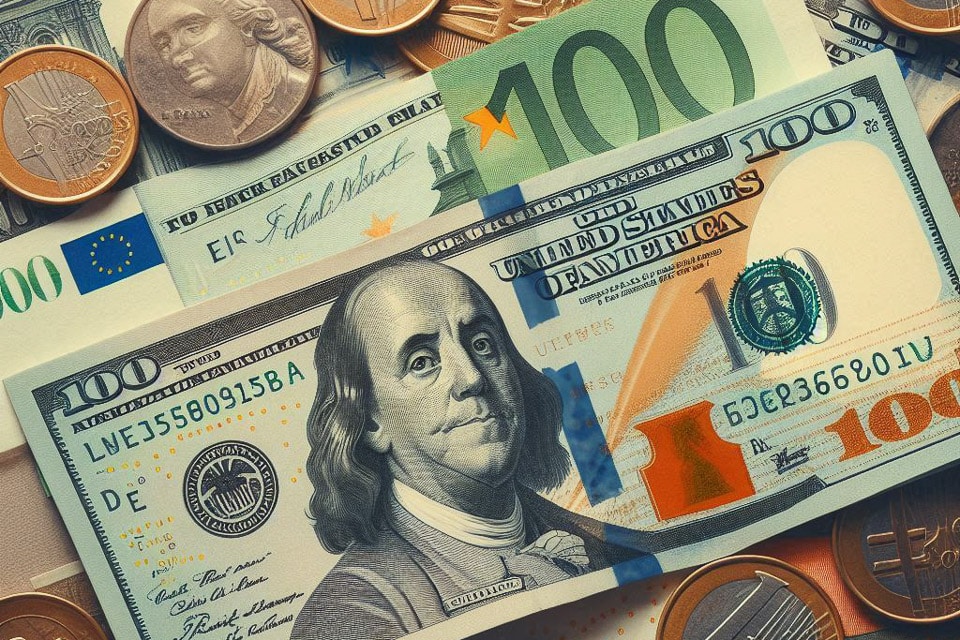
In the various travel online discussion groups we participate in, one of the most frequently asked questions is how to best change your money into the local currency when you're in a foreign country.
When we first starting traveling internationally years ago, that answer was easy: carry American Express traveler's checks, and exchange them for foreign currency at the American Express office or an established bank wherever you were.
Obviously, that's not how foreign transactions are done today. Whether it's withdrawing foreign currencies from an ATM that takes Visa or Mastercard debit cards, or simply tapping your credit card on the payment machine, things are much easier and the foreign transaction fees can be much lower.
How much is at stake when you exchange money the wrong way instead of the right way?
Let's look at US dollars to euros based on the exchange rate today (May 15, 2024.) Today, $100 should buy you €92 at the bank exchange rate. But, if you go to your own bank in the US, you'd be lucky to get €85 for your $100. (That's actually the rate my bank offered me today.) And you'd probably be paying a fee besides. (Again, my bank would have charged me $10 on top of the lousy exchange rate.)
Let's say you're in Europe for two weeks, staying in hotels, eating in restaurants, and buying a few souvenirs. The difference in the high fees your bank charges you to get euros, British pounds or Swiss francs in advance and the best rates you can get by waiting might add up to hundreds of dollars.
Here are the best ways to get the best exchange rates when you travel.
Pay with credit cards whenever possible
The first rule of foreign currency exchange is to pay with a credit card whenever possible. The credit card companies are privy to the best competitive exchange rates. Think of the combined financial clout of Visa or Mastercard when it comes to negotiating fees. Your getting that best rate your credit card company provides assumes, though, that you follow the tips below.
 Want more tips like these?
Want more tips like these?
Join the 3500 other travel enthusiasts getting our best advice right in their inbox. And get our 50 best travel tips sent to you right away!
Get a credit card with no foreign exchange fees
The first and best way to get the best rates is to be sure your credit card has no foreign exchange fees. Today, most credit cards that are designed for travel fill this requirement. Chances are, however, if your card was issued by your small local bank or credit union, you may get nicked for around three percent on every foreign transaction. One more tip: be sure your card has tap and pay enabled. That's how the rest of the world works. It's much more secure than swiping the magnetic strip.
One more thing: Visa and Mastercard are pretty much universally accepted. That's not true with American Express or Discover. Especially, a lot of smaller shops and restaurants will not accept American Express. Be sure you have the right card. (Your Amex card will probably be fine in your hotel and with larger vendors.)
Always choose to be charged in the local currency
A trick by the foreign banks that's popped up in the last couple of years is, when you tap your card on the payment machine, it asks if you want to pay in U.S. dollars or the home currency. Don't fall for it. Always choose the local currency. For the “convenience” of doing the so-called “dynamic currency conversion” for you, the local service provider will charge you in the vicinity of a 10 percent premium. Let your credit card issuer do the exchange, which they will do when you pay in the local currency.
Read our story on how to choose the best credit card for your travel style.
Use mobile phone payments
In addition to tap and pay cards, most foreign vendors will also accept phone payments using Apple Pay or Google Pay. Just like using the card itself, always choose to pay in the local currency when asked. Paying by phone is especially handy on some foreign transport systems, such as Transport for London (the Tube) and Stockholm – to name two we've used recently. London will even cap your spending automatically when you reach the equivalent of a day pass charge.
For when you need cash
Although the vendors in many countries, especially in Europe, have almost gone cashless, there are times when you'll want some cash for tipping or buying something small like a bottle of water or a cup of coffee. That's when you'll hit the ATM.
And the first rule of what ATM to use is the best place to change is at an ATM that is connected to a local bank. And that means on the wall right outside the bank. And when the bank is open. Just in case anything goes wrong, like the machine eats your ATM card – it happens.
Even with the bank ATM withdrawals, just like with credit cards, if you’re given the option, always choose to have a withdrawal debited in local currencies. Some ATMs will try to get you to engage in dynamic currency conversion and dispense the local currency but debit your bank account in a US dollars. Again, don’t fall for it. Always choose a direct withdrawal in the local currency.
Don't exchange money at the airport
Those airport kiosks are notorious for poor exchange rates and extra fees. If you need a taxi or bus to get into the city, chances are very good, especially in Europe, that the taxi will accept a card or electronic payment. If not – and you actually do need cash – look for an ATM with a bank logo.
Whatever you do, do not use Euronet machines or kiosks either at the airport or on the street. They're the worst places with the worst currency exchange rates.
Don't exchange money at home
As I said above, the rates you'll get from US financial institutions are probably terrible. The only reason you might exchange currency at your local bank is if you're absolutely sure you'll need a small amount of local currency to get from the airport to wherever you're going. Then, I suppose you chould exchange a small amount. Don't, whatever you do, try to calculate all the foreign cash you'll need for your trip and get that. That's just changing more money than you have to at a lousy rate. Get cab fare, if you must, then change more when you get to the foreign bank's ATM.
Get a debit card with no foreign exchange fees
Like with credit cards, get a debit card that has no foreign exchange fees. Ask your bank to be sure your card is good. A better idea is to open an account at Schwab Bank and get their debit card. Their card not only has no foreign exchange fees, they also reimburse you for the ATM fees, which can run from €3-7 in a lot of European countries. And whatever you do, don't use a credit card to get a cash advance. The service fee for using a credit card instead of a debit card will kill you.
Watch out for ATM fees
See above. Banks' ATM fees can vary a lot. To beat getting a large string of ATM fees, your best bet is to withdraw all the cash you'll need on one go. One withdrawal equals one fee. Don't withdraw $20 worth every day. If you're worried about carrying a lot of cash, leave most of it in the hotel safe and only carry enough to take care of that day's tipping and coffee needs.
Don't come home with coins
You'll find that most countries don't use bills for smaller denominations any more. For example, the smallest euro note is €5; the smallest British pound note is also £5. If you're planning on reconverting your leftover foreign currency either when you get home or before you leave, you'll find most banks or kiosks won't accept coins.
Donate them in one of the ubiquitous charity bins at the airport. Or, have another cup of coffee.
Up Your Travel Skills
Looking to book your next trip? Use these resources that are tried and tested by us. First, to get our best travel tips, sign up for our email newsletter. Then, be sure to start your reading with our Resources Page where we highlight all the great travel companies and products that we trust. Travel Accessories: Check out our list of all the accessories we carry to make getting there and being there a lot easier. Credit Cards: See our detailed post on how to choose the right travel rewards credit card for you. Flights: Start finding the very best flight deals by subscribing to Thrifty Traveler. Book your Hotel: Find the best prices on hotels with Booking.com. See all of the gear and books we like in one place on our Amazon shop.Got a comment on this post? Join the conversation on Facebook, Instagram, or Threads and share your thoughts!

